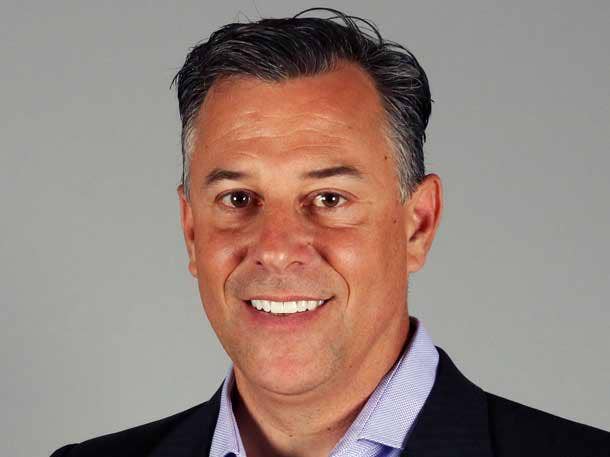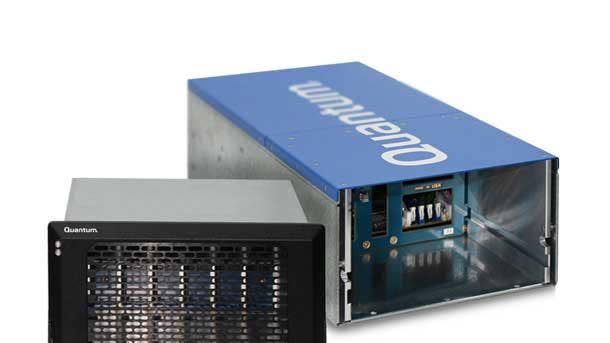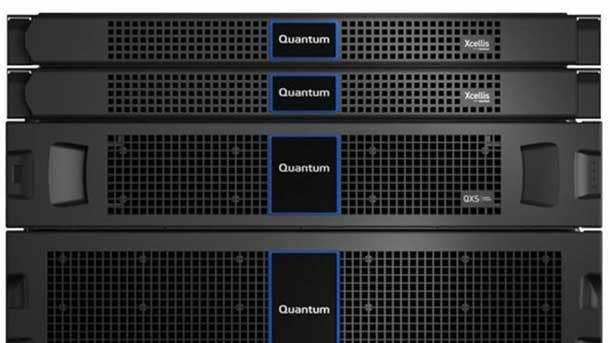CEO Jamie Lerner On Quantum’s NVMe, Edge Computing Focus
‘Putting Quantum into a cubby as a tape business is probably a pretty dated view of the company. It’s something that we sell. But we have object storage, file storage. We have ruggedized edge storage. We have cloud storage. We have data management software,’ Quantum President and CEO Jamie Lerner tells CRN.

Placing Bets On The Future Of Storage
The Quantum of 2020 is nothing like the Quantum of just 10 years ago. The San Jose, Calif.-based storage vendor has moved well beyond its backup tape roots to become a leading provider of file and object storage, NVMe-based storage technology, and offerings aimed at helping a wide range of businesses and government institutions develop technology to meet the growing requirement for archiving data for 100 years and beyond.
Like most technology companies, 2020 has been a challenging year. Quantum saw its revenue drop after the start of the COVID-19 coronavirus pandemic as enterprises and the media and entertainment industry both took hits. But since May, the company has seen its fortunes recover, said Quantum President and CEO Jamie Lerner.
Lerner, speaking with CRN recently in an exclusive interview, said the worst of the pandemic impact is behind Quantum, leaving it ready to continue building on future storage technologies.
“We’re seeing growth in government, in health care, in cloud. In multiple areas around health care and bio-informatics, genetics, research, and more medical imagery or hospital-related activities,” Lerner said. “We’re seeing a lot of growth in those areas, and we’re starting to see a pulse in media and entertainment again with some amount of television and movie productions starting again.”
Here’s a look at the data archiving and data management technologies so important to Quantum’s future, and a peek at the company’s soon-to-be-unveiled StorNext 7 scalable file system.

Where is the growth for Quantum right now?
Our biggest growth is in primary storage, which is really led by our next-generation releases of the StorNext [file system] that we have. We’re currently shipping release 6.4, but we are in early trials of our next version, StorNext 7. We also have StorNext running in the cloud. We have StorNext fully virtualized. It’s software-defined, [with] a whole new tiering and user interface to it. ... StorNext [was] really brought in for more niche applications that need extreme performance to more broad-based IT applications. So I think that’s our primary engine of growth.
Secondly, we’re seeing this idea of a hundred-year archive resonating with many companies. Maybe 30 years ago, many companies’ most valuable assets were physical, they were buildings or inventory or factories and factory equipment. Today, many companies’ most valuable assets are digital, whether it’s a movie company or oil exploration. More and more companies, their most valuable asset is their digital files. And they have to keep those files for, in some cases, not just decades, but in many cases a century or longer, if it comes to human gene or research data that may be taken only once. We have some customers who have satellite data from satellites that aren’t even in orbit anymore. And they’ve got to keep that data for 100 years. And I think we’re one of the first companies to really put together object storage technology with the tiers of storage that are designed to create a hundred-year archive and do it in a ransomware-safe way that’s physically separated from the network.

Where else are you seeing growth?
The other area that’s growing for us is edge computing. We had a lot of success building data center NVMe appliances, but now we have NVMe on the ruggedized edge. We have in-vehicle ruggedized NVMe appliances. We have luggable or carryable NVMe edge appliances, and they’re being used for data transfer, in television show making, in autonomous vehicles. So this kind of edge-to-cloud-to-core transition seems to be one of our other rapid areas of growth. It’s been pretty good.
Is the edge compute business a significant part of your revenue?
It’s becoming more significant. I would say last year we were selling a few boxes here, a few boxes there. And now we’re starting to see people come in and start putting together 1,000-, 2,000-, 4,000-box orders where they’re putting them in larger fleets, larger deployments. And they’re moving through the trial phase and going into at-scale deployment.

So you mentioned StorNext 7. What should we expect to see new with version 7?
It’s an entirely new architecture. I would tell you this is the largest architectural upgrade we’ve made in the last 20 years. First of all, the entire infrastructure of the software is virtualized and in cases containerized. So the product ships as a virtual machine and in containers. Those containers can run software-defined or on purpose-built hardware that we have. The management user interface and API are entirely new. So the ease of install, ease of management, is [new]. An all-new management UI [user interface] with an all-new web services API, so the entire platform is now programmable. The user interfaces can be orchestrated using third-party orchestrators using APIs.
And it has the richest tiering engine that I think the industry’s seen. We’ve been doing hierarchical storage for decades, really between file and tape. And now we’re allowing customers to build pools of storage in any way they’d like. So they can build NVMe pools, SSD pools, hard-drive pools, object cloud. Take pools of storage and build rules that manage data movement between those pools. And then you can be moving files while hundreds of people are editing those files live, and they’re moving between different pools of storage, between on-premises to the cloud, between NVMe disk and tape. [Files] can be moving based on rules that you write, or policies that you write. So it is a major architectural transformation. And the hardware that we ship, because our product runs on virtual machines, you can now put guest VMs on it as well.
Anything else that is new?
You can hyperconverge it as well. We’re not going to market as a hyperconverged player, but one of the side benefits is our systems are fully virtualized, and there’s nothing preventing the customer from installing their own VMs alongside our VM. And there’s enough CPU and memory over-provisioning to allow for that.
And when do you expect to release it?
It will be announced in November, and then probably full production in December.

Quantum was among several multibillion-dollar international companies that took the federal Payroll Protection Program loan from the U.S. government near the start of the pandemic. Did Quantum return that money?
We kept it. I think that controversy that you’re referring to was a pretty wide brush that was used to paint any company other than very small businesses as somehow doing something inappropriate. So we actually stood in front of the House subcommittee. We walked through everything that we did to qualify and show that we qualified exactly to the rules as defined, [and] how we used the money exactly according to the rules. And the government came back to us and really gave us a clean bill of health, and saw no wrongdoing. And not only that, we also fit all the qualifications for forgiveness. So, we went in open-minded. Today, if you think we’ve done something wrong, tell us. We showed an open book of what we’ve done. And today everyone feels we were in full compliance and did everything appropriately. So I think it’s pretty wide brush was used. But when they looked at our individual case, everyone felt we did the right thing.
So what did Quantum use the PPP loan for?
One hundred percent for payroll.
How does your head count look now compared to before the pandemic started?
There’s always people coming and going. But it’s pretty much pretty similar to before COVID.

Quantum traditionally has been known best known for its tape business, and every once in a while someone says tape is dead, even though it isn't. How is Quantum's tape business? Could we see the end of tape some day?
I’ll answer that in two ways. First, I think putting Quantum into a cubby as a tape business is probably a pretty dated view of the company. It’s something that we sell. But we have object storage, file storage. We have ruggedized edge storage. We have cloud storage. We have data management software. So I think one of the things that’s really important for me and as we transform the company is to really get out of this cubby we’ve been put in that we’re a tape vendor. It’s really one product line among many of the things that we do.
And I would say going forward that backup is not really going to be the primary use of tape. Tape has turned out to be, as really researched by the world’s biggest cloud companies who are probably leading the world in data center innovation, they discovered if you’re wrestling with a 100-year data preservation issue and you need to store data safely and cost-effectively for many decades, tape is the most viable way to do that. This is driven by the simple fact that no one has been able to invent a better way to store data than with cellophane with some chemical sprayed on it. You know, hard disks are so much mechanicals and silicon. NVMe is all silicon. And tape is just cellophane. And it’s just extraordinarily inexpensive and can last, when well curated. Getting a decent tape to last 20 years or longer is actually quite common. And so the archiving use cases of tape are growing while backup is, I would say, flat to down.

Quantum remains a channel-focused company, right?
We are just north of 94 percent channel. We do almost all of our business globally through the channel. The channel not only resells our product, some of our channel partners actually provide managed services for our products. Some people actually host our products as a service. A lot of people do professional services around it. So we’ve got a pretty rich ecosystem. I think CRN covered James Mundle (pictured), our new channel chief, who joined us from Veeam where he ran worldwide channels there. So yes, we’re a channel company. We’re transforming our business pretty significantly, but our channel strategy has been one of the things that we think has led to our historic success. And there’s no expectation to make any changes there other than to grow a bigger channel, a wider channel.
One of the things we’re doing is part of our transformation is pressing into a lot more geographies. So we’ve got new sales leaders in Europe and EMEA, a new sales leader in Asia. And they have pretty rich channel backgrounds and are basically driving our expansion strategies through the partner channel.

So as Quantum gets more into 100-year archiving or moving toward the edge or doing more with containers and virtual machines and so on, how have your channel partners changed?
We’ve done a number of things. One is, we’ve begun expanding to more general-purpose IT. I think for a number of years we had very niche partners, niche government, niche media and entertainment. Now we’re working with some larger and more broad-based [partners]. We’ve also focused on partners that can design complete solutions. Our business is evolving from selling the customer a box to solving a business problem. We really want to sit with our customers and say, ’Look, what are the three to five most important business imperatives you have?’ And we want to be relevant in at least two of their five initiatives. And those are business initiatives. We want to be business-relevant. And to do that, you don’t solve a business problem by dropping a piece of equipment at a loading dock. You’ve got to be able to integrate that. You’ve got to be able to design custom business methods and processes. And we need partners that have the ability to gather those kinds of requirements and deliver a full solution. So I think that’s been a big part of our transformation. That, and having a portfolio that’s wide enough with a rich enough set of APIs to allow us to express a business problem or solve a business problem with our technology.
Where is that deep archiving happening?
We work with arguably the world’s largest data centers and the biggest cloud companies around deep archive. Very deep, cold, 10-year, 20-year, 50-year archives of data at exabyte scale. And we’ve been making a lot of progress with them in that the cloud companies are doing well during COVID. But more importantly, they’re all building out exabyte-scale deep archives that can store customers’ data for decades at very aggressive prices. And that’s with very specialized equipment that we’ve been building to meet their needs. Equipment that can be pushed into a corner and still be able to cool itself. Equipment that can be put in trucks. Equipment that can be operated with no tools, no expertise, and can be completely automated through APIs. So really building very specialized equipment where customers can have thousands or tens of thousands of racks, but operate them with incredible simplicity at that kind of scale. And I just think we’re pulling away from the competition and in that exabyte-scale deep archives.